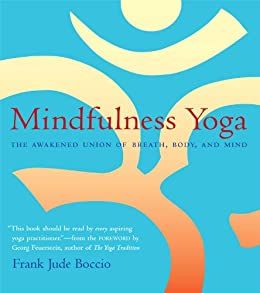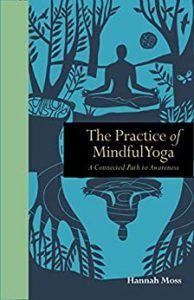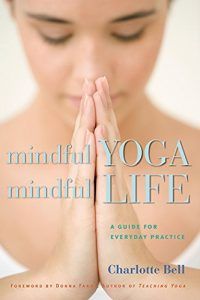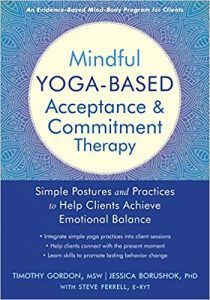What is Mindful Yoga? 4 Poses + Yoga Retreats
 Much is known about the benefits of mindfulness and the benefits of yoga, but what happens when you combine the two together?
Much is known about the benefits of mindfulness and the benefits of yoga, but what happens when you combine the two together?
A relatively new form of yoga called Mindful Yoga, applies traditional Buddhist mindfulness teachings to the physical practice of yoga, offering even deeper insights into the mind and a truly life-changing approach to your practice.
Read on to learn all about its benefits, specific mindful yoga poses, and mindful yoga retreats to help you cultivate greater awareness, consciousness, and improved quality of life.
Before you read on, we thought you might like to download our three Mindfulness Exercises for free. These science-based, comprehensive exercises will not only help you cultivate a sense of inner peace throughout your daily life, but will also give you the tools to enhance the mindfulness of your clients, students, or employees.
This Article Contains:
- A Quick Look at Mindfulness and Yoga
- What Is Mindful Yoga?
- What is the Best Practice Approach?
- Five Proven Benefits
- Why Yoga and Mindfulness Go Together
- Four Mindful Yoga Poses
- Four Recommended Books
- 3 YouTube Videos on Mindful Yoga
- A Look at Yoga Retreats: A Place To Practice Mindfulness
- Five Mindfulness and Mindful Yoga Retreats
- A Take-Home Message
- References
A Quick Look at Mindfulness and Yoga
Merging the practice of mindfulness with the practice of yoga has led the way to a new and more intensive form of “Mindful Yoga.” Mindful yoga applies traditional Buddhist mindfulness teachings to the physical practice of yoga; it is the holistic approach of connecting your mind to your breath. Before we go any further, let us start with a brief overview of mindfulness and yoga, on their own.
Mindfulness Explained
According to meditation teacher, Guy Armstrong:
“Mindfulness is knowing what you are experiencing while you are experiencing it. It is moment-to-moment awareness, has the quality of being in the now, a sense of freedom, of perspective, of being connected, not judging” (Sridhar, n.d.).
Jon Kabat-Zinn—referred to by some as the father of mindfulness—says:
“Mindfulness means paying attention in a particular way; On purpose, in the present moment, and nonjudgmentally” (Sridhar, n.d.).
Mindfulness is simple yet it is complex, in that, it is a way of training yourself to simply focus on whatever is happening in the present moment, yet it can be one of the most transformational tools for personal and spiritual development. It’s no wonder it has been a buzzword in our modern world, with athletes, corporations and wellness professionals alike, all claiming its incredible benefits.
Benefits of practicing mindfulness include, but are not limited to: increased concentration, memory, immunity to colds and diseases, feelings of happiness and contentment; reduction in chronic pain, blood pressure, stress, anxiety, and depression (Moss, 2018).
Mindfulness practice has deep roots in Buddhist tradition, but you certainly do not need to be a Buddhist in order to apply its teachings and techniques to your life.
Yoga Explained
The definition of “yoga” is a bit more complex, as there is no single definition of the word, though in Sanskrit the literal translation is “union.” It is described as a state of connection and a body of techniques that allow us to connect to anything. The experience of having a conscious connection to something is a state of yoga—a joyful, blissful, fulfilling experience (Saraswati, n.d.).
The term “yoga” is also used to describe a comprehensive practice and a way of life. It is estimated to be at least 5,000 years old, originating in India and brought to the west in the 1920s (Joshi, 2018). Yoga has been described as the ancient Indian science of self-realization, or the ancient science of self-culture. Or as the renowned sage, Patanjali, puts it, yoga is “a method to stop thought waves” (Yogamandiram, 2017).
The real secret to yoga can possibly be summed up in one word: awareness (Saraswati, n.d.). To many, the modern day understanding and practice of yoga is quite different, and perhaps quite a bit removed from its traditional meaning.
“Modern yoga is a physical activity consisting largely of postures called asanas, often connected by flowing sequences called vinyasas, sometimes accompanied by the breathing exercises of pranayama, and usually ending with a period of relaxation or meditation” (De Michelis, 2017).
According to the “Yoga Sutras” (ancient texts written by Patanjali), yoga asana is just one of yoga’s eight limbs (Joshi, 2018), but for the purposes of understanding today’s modern practice of “mindful yoga,” we will stop here.
What Is Mindful Yoga?

The difference between Mindful Yoga and the wide variety of yoga practices out there is that with Mindful Yoga, the main focus is on mind-body awareness, as opposed to alignment details and the exact physical posture. The point is to cultivate mindfulness, using asana as the vehicle in which to do so.
Bringing mindful awareness to any physical activity creates an alert focus to whatever you are doing in that exact moment, thereby transforming the movement into a form of meditation. Therefore mindful yoga is considered to be a form of meditation, and/or it is very often practiced before a formal meditation sitting.
Another characteristic of this type of yoga is its emphasis on observing rather than reacting. Although this should always be the case in yoga, this practice, in particular, places great importance on observing your mind and feelings while you are acting out the yoga pose.
Mindful yoga is a key component of the popular eight-week evidence-based program, Mindfulness-Based Stress Reduction (MBSR)—a practical training program developed by Professor Jon Kabat-Zinn, that assists people with stress, anxiety, depression, and pain. (Kabat-Zinn, 2005)
Most indicatively, mindful yoga applies traditional Buddhist mindfulness teachings to the physical practice of yoga, as a way to strengthen awareness and presence both on and off the yoga mat. Specifically, this type of yoga applies the Buddha’s Four Foundations of Mindfulness to systematically cultivate self-awareness and compassion through non-judgment, patience, beginners mind, trust, non-striving, letting go, and gratitude (Boccio, 1993).
NOTE: The Mindful Yoga approach can be applied to any yoga class you take!
What is the Best Practice Approach?
The best practice approach to mindful yoga is a systematic one, with clearly defined and repeatable steps. Instead of just “practicing mindfully,” which generally means to pay attention to your breath and alignment details throughout your practice, Boccio (1993) suggests applying the Buddha’s teachings on the four foundations of mindfulness, throughout your practice.
These detailed instructions can be applied within any pose, and by doing so systematically, you’re able to identify specific behaviors and make positive changes. For example, behaviors such as grasping for the outcome of a pose, avoiding certain poses altogether, or completely zoning out from your practice (Isaacs, 2008).
Body Scans
When you practice mindful yoga, you should scan the body and be on the lookout for the many ways—some subtle, others not so subtle—in which your perspective on your body, thoughts, and whole sense of self can shift when you change postures and stay in them for some time, paying full attention from moment to moment.
Practicing in this way enriches the inner work enormously and takes it far beyond the physical benefits that come naturally with the stretching and strengthening.
(Kabat-Zinn, 2005)
The main point with mindful yoga is to be curious and open to what you are noticing—without judgment or attachment—investigating your bodily sensations as fully as possible, and then intentionally releasing the focus of attention before shifting to the next area to explore (Smookler, 2016). Remember to be curious; when the mind wanders, notice any irritation or judgment, and then bring your mind back to the breath and the body.
Teacher’s Instruction
Once instruction has been given to the students on how to get into the posture, teachers might remind students to cultivate mindfulness by asking them pointed questions, such as:
How is your breath? Is it shallow or is it deep? Is it fast or is it slow?
Where is sensation arising in your body?
Are you staying present, or are you wondering when this pose will end?
Are you staying present, or are you comparing yourself to your neighbor?
Teachers will keep reminding students to come back to the present moment and to observe the truth of what is happening in that moment. This helps students learn that their thoughts are not the truth, but rather, things they have conditioned themselves to believe over time. Through the practice of mindful yoga, students begin to notice the pattern, name it, and then start to investigate it.
Applying the Four Foundations of Mindfulness
When you apply the Buddha’s Four Foundations of Mindfulness to your asana practice, it becomes a fully integrated mindfulness practice. On any given day you can choose to devote your practice to any one of the four foundations, or work through them sequentially.
1. Mindfulness of Body
This is the awareness of the body as body; a reminder that the body is actually a collection of many parts. Skin, bones, teeth, nails, heart, lungs and all other parts; each is actually a small “body” located within the larger entity that we refer to as “the body.”
In this foundation we train ourselves to observe the body part by part, rather than trying to observe the whole body at once, making mindfulness much more accessible.
When we look at the body as composed of many parts, it also helps us to see the body as a body and not as “my” body or as “myself.” It is simply a physical form like all other physical forms. Since it is not “myself,” the body can also be called “selfless.”
This foundation helps us to recognize that the body is impermanent, subject to injury, illness, and death, and therefore not a source of lasting happiness. In the Buddha’s words, it teaches us to “know the body as it really is.”
2. Mindfulness of Feelings
Mindfulness of feelings refers to both bodily sensations and emotions. Similarly to the body, feelings can also be subdivided. Here the Buddha is telling us to contemplate “the feeling in the feelings.” Whether they be pleasant, unpleasant, or neutral, we learn to observe and fully acknowledge our feelings, and that they eventually always dissipate.
Through this foundation, one learns to simply observe feelings as they come up, and not identify with them or attach any judgment to them. They do not define who you are, they are simply feelings. Seeing a feeling as an emotion or sensation rather than “my” feeling, we come to know that feelings are selfless. In this way, Buddha says we recognize the truth about feelings. In other words, we “know feelings as they really are.”
3. Mindfulness of Mind
Mindfulness of mind is not referring to the thinking mind, rather, it is more like consciousness or awareness. Again, we talk about the mind as if it were a single object, but it is actually a series of particular instances of “mind in mind.”
This foundation of mindfulness teaches us that consciousness arises from moment to moment, on the basis of information coming to us from the senses, as well as from internal mental states. The mind on its own cannot exist, only certain states of mind that appear, depending on internal or external conditions.
When we pay close attention to the way each thought arises, and then passes away, we gain some understanding that we are not our thoughts. We learn not to attach our identity to our thoughts and we come to know “mind as it really is.”
4. Mindfulness of Dharma
The word “dharma” is another Sanskrit word that is as difficult to define as the word “yoga.” It can simply be described as ”natural law” or “the way things are.”
This foundation of mindfulness is sometimes called “mindfulness of mental objects.” With this teaching, we learn that everything around us exists for us as mental objects; manifestations of reality. They are what they are because that’s how we recognize them.
Mindfulness of Dharma is to practice awareness of the inter-existence of all things, and awareness that they are temporary, without self-essence, and conditioned by everything else.
*The Four Foundations of Mindfulness is cited from O’Brien (2017) and Gunaratana (2018).
Five Proven Benefits
The unique benefits of Mindful Yoga are plentiful, and have been recognized by top researchers at Harvard Medical School as well as Massachusetts General Hospital’s Depression Clinical and Research Program (Powell, 2018).
Below we outline some of the main benefits of practicing mindfulness on the yoga mat.
1. A deep sense of awareness / opening into the self
Generally speaking, the practice of mindfulness results in an expansion of your perspective and of your understanding of who you are (Kabat-Zinn, 2005). With mindful yoga, we learn to become astutely aware of habitual patterns of reactivity. For example, do you hold your breath when going deep into a twist? Do you become agitated or angry during challenging poses, and wish for them to be over?
This type of keen mind-body awareness becomes a tool for transformation outside of the yoga practice, because it is through awareness that we grow our ability to see—and be with—things as they are. Training our awareness helps us to shift away from characteristics than are holding back our growth, such as resistance to what is, playing the victim, and reacting to things as opposed to responding to them (Dodd, n.d.).
2. Helps one to face the challenges of everyday life / demonstrate less reactivity
Mindful yoga practice encourages patience and discourages reactivity on the mat, which in turn gives rise to more patience and less reactivity off the mat. This can be seen in all areas of one’s life, including work, relationships, social life and leisure activities (Moss, 2018).
This increased sense of patience can make conflicts and confrontations easier to navigate, as with practice, we learn to stop and reflect before we react, according to our patterns.
3. Acceptance
Through the mindful yoga practice, we learn to let go and accept situations for what they are in that moment. Taking this into everyday life can be incredibly valuable, as when we accept a perceived negative situation for what it is, we begin to neutralize it, and more easily move through it.
Acceptance is even known to help those with depression, for example, as when you begin to accept your depression you start to take power away from it, and also realize that it is just thought and feeling, it is not you.
Practicing acceptance on the mat prepares you for real life, as you truly do not get to choose what’s going to happen next. Mindful yoga teaches you to roll with the punches.
4. A heightened sense of compassion and non-judgment for the self and others
Increased compassion, kindness, and understanding, are all things that we can take off the mat and carry into our everyday existence, through regular practice of mindful yoga.
As mindful yoga increases your awareness and understanding of the truth—of body, feelings, mind, dharma—it deepens your recognition of basic goodness in yourself and in others (Isaacs, 2008).
Specific “heart opening” poses throughout the yoga practice also aim to support a healthy, open heart (this is in the emotional sense, not the physical heart). As the heart chakra is related to our ability to give and receive love, regular mindful yoga practice helps to heal emotional blockages and letting go of negative beliefs.
5. Deepen your personal yoga practice
Another benefit of mindful yoga is that it can deepen, and start to bring more meaning to your personal yoga practice. For some, after many years of practice, yoga can become part of a daily checklist, or merely a form of exercise. When the practice starts to become something you are doing through routine movement and not through conscious thought, it is no longer yoga.
Mindful yoga by its very nature, turns you off of “autopilot,” and opens you more deeply into your practice. It can also act as a bridge between the practice of asana and the practice of meditation, for those who don’t have a lot of experience in or understanding of meditation techniques.
Why Yoga and Mindfulness Go Together
Yoga and mindfulness go together because the aim of both is to achieve a higher level of connection, awareness, or union, between the mind, body, and spirit. In fact, yoga without mindful awareness cannot be yoga.
Both yoga and mindfulness aim to quiet the mind, in order to cultivate a deeper connection to and understanding of the self. They both teach you to tune into your breath, pay attention to bodily sensations, and learn to accept reality as it is in that moment.
Mindfulness is something that we cultivate through yoga practice. The yoga studio also happens to be the perfect setting for learning to become more mindful, since it is replete with conditions that are beyond our control.
Some days you might feel restless or bored, or agitated by the noises coming from outside the yoga studio or perhaps from the person on the mat next to you. Mindful yoga trains you to reframe these conditions and feel less reactive towards them (Isaacs, 2008).
Lastly, yoga practice is something that helps prepare the body for mindful meditation. The two have always been inextricably connected, with a physical yoga practice only leading to enhanced mindfulness, and a regular mindfulness/mindfulness meditation practice only leading to a stronger yoga practice. If you take a look at Patanjali’s eightfold yogic path, you see that “oneness” is the final goal of mindful meditation.
So yoga and mindfulness are not just two things that go together well, they are actually two parts of a whole, ancient wisdom model for achieving a higher level of consciousness (Joshi, 2018).
Four Mindful Yoga Poses

Just as there are certain poses that stretch and/or strengthen your body, and poses that give you energy, there are also poses that prepare your body for meditation.
These mindful yoga poses are purposefully simple, as they help to slow down your breath as well as your body, quiet the mind, and of course, heighten your awareness.
1. Tadasana – also known as “Mountain Pose”
This pose is the foundation for all standing postures. It is so seemingly simple that it is often not practiced mindfully. It is an excellent posture to help bring awareness to all areas of the body, as well as the mind, to see if it is wandering off.
Cues:
Stand up tall with your arms at your sides. Press all four corners of your feet into the ground, distributing your weight evenly between both feet. Imagine your pelvis as a bowl with its rim level, both side to side and front to back.
Elongate the spine, keeping the lower ribs from jutting out, gently lifting the chest and opening the heart. Relax the shoulders down your back. Keep your chin parallel to the floor and your ears centered over your shoulders.
2. Vrikshasana – also known as “Tree Pose”
The classic balancing posture, Tree Pose helps focus your mind on finding balance on one standing leg. This is another simple pose that has the tendency to let the mind wander off. As well, since it is a balancing pose, the loss of balance may cause one to experience feelings of defeat or judgment, should they be unable to maintain the balance.
Cues: (posture to be completed on each side)
Standing tall with your arms at your sides, start to shift your weight to your right foot.
Inhale while lifting the opposite leg, rotating it externally. Use your left hand to help guide the sole of your left foot onto your inner right thigh. Bring your hands to your chest in Prayer position.
Your left foot should be pressing firmly into your right thigh, and right thigh pressing firmly into your left foot. Maintain this pose while breathing in and out.
3. Anjaneyasana – also known as “Low Lunge”
Low Lunge is a stretching posture which improves balance, concentration and core awareness. During this pose, it is common to lose conscious awareness of the breath, or might evoke a desire for the pose to be over, making it a great exercise in mindfulness.
Cues: (posture to be completed on each side)
Starting from Downward-Facing Dog Pose, step your right foot forward and place it beside your right thumb, lining up your right knee over your right ankle. Lower your left knee down to the ground, ensuring to place it behind your hips. Raise your torso and sweep your arms above your head, palms facing one another, biceps beside your ears.
Allow your hips to settle forwards and down until you feel a stretch in the front of your left leg and psoas muscle. Draw your tailbone down, lengthening your lower back and engaging your core muscles. Begin to draw your thumbs into the back plane of your body as you reach up with your heart, shifting your gaze upward for a mild backbend.
4. Supta Baddha Konasana – also known as “Reclining Bound Angle Pose”
A classic restorative posture, this is a great ending posture for mindful yoga practice, acting as a segway into meditation as it brings awareness inward. In this posture, the mind might start to wander due to physical discomfort in the inner thighs and groin.
Cues:
Starting from Corpse Pose, bring the soles of your feet together, and let your knees fall open. Imagine that your inner groins are sinking into your pelvis. Extend your arms out by your side, angled at about 45 degrees from the sides of your torso, palms facing up.
Start to relax your face, chest, shoulders, hips, and feet. Allow your knees to drop further, as you go deeper into the pose.
You might want to peruse our article on yoga in education as well, as it includes seven additional poses.
Four Recommended Books
A great way to expand your knowledge on yoga, besides practicing it, is to invest in any of the following books. They are all great reads and come highly recommended.
1. Mindfulness Yoga: The Awakened Union of Breath, Body, and Mind – Frank Jude Boccio

In the first part of the book, Boccio gives a lively introduction to the Buddha’s teachings within the larger context of the ancient wisdom texts.
In the second half of the book, he offers complete Mindful Yoga sequences, with photography and detailed cues for breath, body, and mind.
Available from Amazon.
2. The Practice of Mindful Yoga: A Connected Path to Awareness (Mindfulness) – Hannah Moss

In The Practice of Mindful Yoga, Moss offers practical exercises for beginners, experienced practitioners and everyone in between, on how to live a more mindful life on and off the mat.
Available from Amazon.
3. Mindful Yoga, Mindful Life: A Guide for Everyday Practice – Charlotte Bell

As a longtime yoga teacher and Buddhist meditation practitioner, she shares stories and insights, honoring these timeless teachings while staying relevant to modern times.
Bell inspires readers through her writings on self-doubt, relationships, music, and more, and to bring mindfulness into their asana practice through daily practices such as reflections.
Available from Amazon.
4. Mindful Yoga-Based Acceptance and Commitment Therapy – Timothy Gordon MSW, Jessica Borushok Ph.D., Steve Ferrell E-RYT

The book offers tools and foundational understanding for mental health professionals who are interested in mindfulness, yoga, and holistic approaches to health, as well as yoga teachers looking to incorporate research backed health care interventions into their yoga practice and teaching.
Available from Amazon.
3 YouTube Videos on Mindful Yoga
While there are many videos on yoga, we present the following selection of mindful yoga YouTube videos
1. Mindful Yoga 1
In this detailed description of mindful yoga and practical application, University of Missouri System guides you through a mindful hatha yoga practice for just over one hour. The video is part of the Mindfulness-Based Stress Reduction Program created by Jon Kabat-Zinn.
Through succinct and well-timed direction, in the video the instructor continually reminds viewers to come back to the present moment, focus on the breath, and notice any thoughts without giving them any energy.
2. Jon Kabat-Zinn Mindful Standing Yoga
In this short and simple video, Jon Kabat-Zinn engages listeners with his soothing voice, taking them through a gentle, eleven-minute mindful standing yoga sequence.
Encouraging moment to moment awareness throughout, Kabat-Zinn uses simple words and examples to describe poses, making it very accessible for beginners.
3. Ten Mindful Movements – Plum Village and Thich Nhat Hahn
This video is included as an alternative for the yoga practices of the free online Mindfulness-Based Stress Reduction course (MBSR). The video demonstrates a standing mindful yoga sequence of just ten movements/poses, and is just over half an hour.
The movements are demonstrated twice, first by a student monk, and then by Thich Nhat Hanh himself (Hanh is a global spiritual leader, Buddhist monk and peace activist).
A Look at Yoga Retreats: A Place To Practice Mindfulness
To be able to have a place where you can go for 60 to 90 minutes, one to several times per week, to practice mindful yoga is really something to be grateful for. Even to have the ability, time, space, etc., to practice from your own home, is a great advantage. The benefits of one’s mindful yoga practice are sure to appear off the mat eventually, and for many that is the ultimate goal: to enhance one’s wellbeing in everyday life.
Imagine you were able to set aside an entire week, or maybe ten days or even two weeks, to fully immerse yourself into your practice and to reconnect with yourself. Yoga retreats allow for this to be possible.
Yoga retreats allow us to step out of our everyday reality, slow ourselves way down, and get back to the basics. The basics being, our physical, emotional, and mental states.
Stripped down of our to-do lists, removed from our digital devices, and all other distractions and responsibilities, retreats offer a unique space to cultivate greater awareness and consciousness.
Though we can cultivate this through our regular practice, be it one hour every day or one hour every week, a retreat is a fully immersive space where you can allow yourself to just be, for the entire duration.
Another reason why yoga retreats are an ideal place to practice mindfulness is that they are led by experts, and usually open to “all levels.” This means that you will learn the foundations of yoga or mindful yoga before you delve deeper, and always have an expert there with you to answer any questions you may have while you’re learning.
A typical yoga retreat runs anywhere from three days to two weeks, with the average retreat taking place over one week. The added bonus of having a retreat location somewhere tropical is always nice, but at the least, you should opt for a retreat that takes you far enough from home that you can feel you have disconnected from the responsibilities there.
A retreat should be a place where you can let go of any stress or problems you are dealing with back home, and sometimes a bit of physical distance can help to achieve this, although it’s not necessary.
The best yoga and mindfulness retreats offer twice-daily yoga classes, usually an energizing yang class in the morning and a nurturing yin class in the evening. Time is usually set aside for meditation and breathwork (pranayama), as well as the physical asana practice (Mindful yoga retreats to restore your body and mind, 2018).
Four Mindfulness and Mindful Yoga Retreats

1. Kripalu Center for Yoga & Health
Location: Stockbridge, Massachusetts
“Explore the power of you.” Kripalu offers more than 700 programs/retreats per year, across yoga, mindfulness, meditation and more. Retreats include daily yoga courses, natural-foods cuisine, massage, hiking, saunas, scenic views of mountains and lake, and a private beach.
Book on their website.
2. Eat Pray Move
Location: Global retreats offered
#DoGoodTravelWell. Eat Pray Move hosts boutique, curated yoga retreats all over the world, in countries such as India, Iceland, Morocco, and Croatia. Retreats are for all levels of yogis, and the organization gives 10% of their profits to global non-profits.
Book on their website.
3. Esalen Institute
Location: Big Sur, California
On ancient ground, opening new horizons. This retreat center and educational institute span 120 acres of cliffside hot springs, farm and garden, resting between mountain and ocean. Esalen Institute is devoted to cultivating deep change in self and society and offers up to 600 workshops and programs per year, in yoga, meditation, mindfulness and more.
Book on their website.
4. The Sanctuary Thailand
Location: Koh Phangan, Thailand
It’s time for you to meet the sanctuary. Known for world-class yoga teachers, health food and detox programs, The Sanctuary offers yoga retreats, workshops and teacher training in a remote jungle setting. Their renowned organic menu offers vegetarian, seafood and raw food options.
Book on their website.
A Take-Home Message
I hope that this piece gave you a good understanding of what Mindful Yoga is and how it differs from the variety of yoga styles you would typically find in studios. The aim of mindful yoga is to cultivate mindfulness and prepare yourself for meditation, using the physical act of yoga (asana) as the vehicle in which to do so.
A key takeaway is that combining mindfulness and yoga can create even more benefits than each practice on its own, including an even deeper sense of self-awareness and acceptance, as well as compassion for the self and others.
Mindful Yoga postures and sequences tend to be simpler than in other styles of yoga, as this practice is meant to slow down your breath, your body, and your mind, in order to heighten your awareness of the present moment.
Mindful Yoga utilizes Buddhism’s Four Foundations of Mindfulness throughout the practice, but you do not have to be a Buddhist or have any particular interest in the religion in order to take part in Mindful Yoga and reap its amazing benefits.
For a more in-depth understanding of Mindful Yoga, I encourage you to have a look at the suggested YouTube videos and suggested readings! Thank you for reading and please feel free to leave your comments in the section below.
We hope you enjoyed reading this article. Don’t forget to download our three Mindfulness Exercises for free.
- Boccio, F.J. (1993). Mindfulness Yoga: The Awakened Union of Breath, Body, and Mind. Boston, MA: Wisdom Publications.
- De Michelis, E. (2007). A Preliminary Survey of Modern Yoga Studies. Journal of the International Association for the Study of Traditional Asian Medicine. 3: 1-19.
- Dodd, D. (n.d.). Growing your awareness on and off the mat. Retrieved from https://www.ekhartyoga.com/articles/practice/growing-your-awareness-on-and-off-the-mat
- Gunaratana, B.H. (2018, May 9). The Four Foundations of Mindfulness. Retrieved from
https://www.lionsroar.com/living-with-awareness-an-excerpt-from-the-four-foundations-of-mindfulness-in-plain-english/ - Isaacs, N. (2008, October 21). Bring More Mindfulness Onto the Mat. Retrieved from https://www.yogajournal.com/practice/peace-of-mind
- Joshi, P. (2018, July 19). Do You Really Know the True Meaning of Yoga? Thoughts from a British Indian Yogi. Retrieved from https://www.yogajournal.com/yoga-101/the-true-meaning-of-yoga-thoughts-from-a-british-indian-yogi
- Kabat-Zinn, J. (2005). Full catastrophe living: Using the wisdom of your body and mind to face stress, pain, and illness (Delta trade pbk. reissue.). New York, N.Y.: Delta Trade Paperbacks.
- Mindful yoga retreats to restore your body and mind. (2018, August 20). Retrieved from https://www.psychologies.co.uk/mindful-yoga-retreats-restore-your-body-and-mind
- Moss, H. (2018). The Practice of Mindful Yoga: A Connected Path to Awareness (Mindfulness). Lewes, UK. Leaping Hare Press.
- O’Brien, B. (2017, July 10). The Four Foundations of Mindfulness. Retrieved from https://www.thoughtco.com/the-four-foundations-of-mindfulness-450066
- Powell, A. (2018, April 9). When science meets mindfulness. Retrieved from https://news.harvard.edu/gazette/story/2018/04/harvard-researchers-study-how-mindfulness-may-change-the-brain-in-depressed-patients/
- Saraswati, S.S. (n.d.). Definitions of Yoga. Retrieved from https://www.bigshakti.com/definitions-of-yoga/
- Smookler, E. (2016, March 10). Beginner’s Body Scan Meditation. Retrieved from https://www.mindful.org/beginners-body-scan-meditation/
- Sridhar, V. (n.d.). What is Mindfulness? Retrieved from https://www.ekhartyoga.com/articles/practice/what-is-mindfulness
- Yogamandiram, R. (2017, January 29). Origin and meaning of the word ‘Yoga.’ Retrieved from https://medium.com/raja-yogamandiram/origin-and-meaning-of-the-word-yoga-8177fbd86aa
Let us know your thoughts
Read other articles by their category
- Body & Brain (42)
- Coaching & Application (54)
- Compassion (26)
- Counseling (50)
- Emotional Intelligence (24)
- Gratitude (18)
- Grief & Bereavement (21)
- Happiness & SWB (39)
- Meaning & Values (25)
- Meditation (20)
- Mindfulness (44)
- Motivation & Goals (43)
- Optimism & Mindset (32)
- Positive CBT (25)
- Positive Communication (20)
- Positive Education (44)
- Positive Emotions (30)
- Positive Leadership (13)
- Positive Psychology (32)
- Positive Workplace (33)
- Productivity (16)
- Relationships (41)
- Resilience & Coping (34)
- Self Awareness (20)
- Self Esteem (36)
- Software & Apps (13)
- Strengths & Virtues (30)
- Stress & Burnout Prevention (33)
- Theory & Books (44)
- Therapy Exercises (35)
- Types of Therapy (58)





What our readers think
Thanks for sharing such important information your content is very impressive. I like your explanation of the topic and the ability to do work. I really found your post very interesting.
Nice Article! Loved To Read, Keep up the Work
Yoga is a natural method to get rid of the tension accumulated daily, both in the physical and mental body. Indeed, postures and pranayamas are effective techniques to release stress, often manifested as contractures in the neck, back and joints.
where can I find a course in England to become mindfulness yoga teachers
Yoga is a perfect way to achieve harmony, improve your health and body. I started to practice yoga a year ago. And what can I say? It changed my life. I started to wake up earlier and did yoga before breakfast and work. It helped me to lose weight, improved my well-being and the quality of sleep. I became more patient and strong.
Everyone should try to practice yoga 🙂 And your article will help to achieve better results!